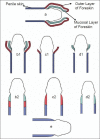Removal of foreskin remnants in circumcised adults for treatment of premature ejaculation
- PMID: 21747599
- PMCID: PMC3130485
- DOI: 10.4103/0974-7796.82175
Removal of foreskin remnants in circumcised adults for treatment of premature ejaculation
Abstract
Background and aim: Premature ejaculation (PE) is the most prevalent sexual dysfunction in every country. There are many types of treatment, but the main limitation of medical treatment for premature ejaculation is recurrence after withdrawal of medicine. The prepuce is a specific erogenous zone that contains a rich and complex network of nerves. Circumcision radically desensitizes the penis, but incomplete circumcision may cause premature ejaculation. We evaluate the effect of removal of foreskin remnants in adults on PE.
Materials and methods: The sensitive area of penile skin and the remaining parts of foreskin in adult men were recognized in 47 selective patients. Under local anesthesia, the remnant parts of foreskin were incised and removed. They were asked to fill the investigating questionnaire about the changes of intravaginal latency ejaculatory time (IVELT), patients and their sexual partners' satisfaction with sexual life, control over ejaculation, and penile sensitivity, before and after treatment.
Results: There were no signs of inflammation and no serious adverse reactions in all cases after operation. IVELT significantly increased from 64.25 before surgery to 731.49 sec after surgery (P<0.001). The percentage of postoperative satisfaction in both the patient and his partner significantly increased (P<0.001). After surgery, 95.7% of men had better control over their ejaculation. This surgery significantly decreased sensitivity of penis (P<0.001), but it did not change glans penis insensitivity.
Conclusions: These results indicate that removal of foreskin remnants in adults is an effective modality in selective patients of PE.
Keywords: Circumcision; foreskin; premature ejaculation; prepuce.
Conflict of interest statement
Figures


Similar articles
-
The prevalence of an excessive prepuce and the effects of distal circumcision on premature ejaculation.Arab J Urol. 2017 Apr 7;15(2):140-147. doi: 10.1016/j.aju.2017.02.002. eCollection 2017 Jun. Arab J Urol. 2017. PMID: 29071143 Free PMC article.
-
Male circumcision decreases penile sensitivity as measured in a large cohort.BJU Int. 2013 May;111(5):820-7. doi: 10.1111/j.1464-410X.2012.11761.x. Epub 2013 Feb 4. BJU Int. 2013. PMID: 23374102
-
Topical lidocaine-prilocaine spray for the treatment of premature ejaculation: a proof of concept study.Int J Impot Res. 2003 Aug;15(4):277-81. doi: 10.1038/sj.ijir.3901011. Int J Impot Res. 2003. PMID: 12934056
-
[Prepuce in boys and adolescents: what when, and how?].Med Pregl. 2012 Jul-Aug;65(7-8):295-300. doi: 10.2298/mpns1208295d. Med Pregl. 2012. PMID: 22924249 Review. Serbian.
-
Glans penis augmentation using hyaluronic acid for the treatment of premature ejaculation: a narrative review.Transl Androl Urol. 2020 Dec;9(6):2814-2820. doi: 10.21037/tau-20-1026. Transl Androl Urol. 2020. PMID: 33457252 Free PMC article. Review.
Cited by
-
New insights on premature ejaculation: a review of definition, classification, prevalence and treatment.Asian J Androl. 2012 Nov;14(6):822-9. doi: 10.1038/aja.2012.108. Epub 2012 Oct 15. Asian J Androl. 2012. PMID: 23064688 Free PMC article. Review.
-
Premature ejaculation: do we have effective therapy?Transl Androl Urol. 2013 Mar;2(1):45-53. doi: 10.3978/j.issn.2223-4683.2013.01.02. Transl Androl Urol. 2013. PMID: 26816723 Free PMC article. Review.
-
Association of redundant foreskin with sexual dysfunction: a cross-sectional study from 5700 participants.Asian J Androl. 2025 Jan 1;27(1):90-95. doi: 10.4103/aja202461. Epub 2024 Aug 20. Asian J Androl. 2025. PMID: 39162146 Free PMC article.
-
[Male circumcision is not associated with an increased prevalence of erectile dysfunction: results of the Cottbus 10,000-men survey].Urologe A. 2013 Apr;52(4):562-9. doi: 10.1007/s00120-012-3112-2. Urologe A. 2013. PMID: 23361453 German.
-
Evaluation of clinical curative effects of disposable stitching instrument in redundant prepuce patients.Exp Ther Med. 2017 Jul;14(1):298-302. doi: 10.3892/etm.2017.4453. Epub 2017 May 11. Exp Ther Med. 2017. PMID: 28672929 Free PMC article.
References
-
- Jannini EA, Lenzi A. Epidemiology of premature ejaculation. Curr Opin Urol. 2005;15:399–403. - PubMed
-
- Hosseini SR, Khazaeli MH, Atharikia D. Role of postcircumcision mucosal cuff length in lifelong premature ejaculation: A pilot study. J Sex Med. 2008;5:206–9. - PubMed
-
- Waldinger MD. The neurobiological approach to premature ejaculation. J Urol. 2002;168:2359–67. - PubMed
-
- Hosseini SR. Does a constriction ring alter ejaculation latency? BJU Int. 2007;100:619–20. - PubMed
-
- Safarinejad MR. Analysis of association between the 5-HITTLPR and STin2 polymorphoisms in the serotonin transporter gene and clinical response to a selective serotonin reuptake inhibitor (sertraline) in patients with premature ejaculation. BJU Int. 2010;105:73–8. - PubMed
LinkOut - more resources
Full Text Sources
Other Literature Sources

